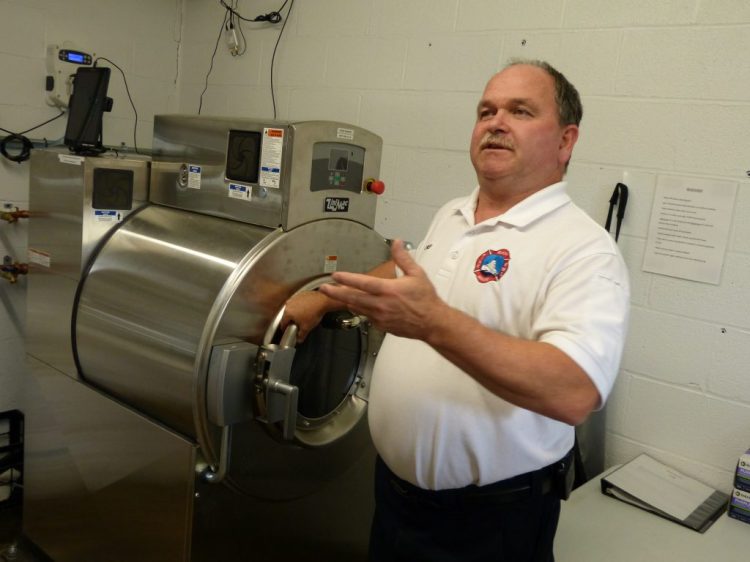Portland firefighter Mike Nixon has been battling fires since 1986. Every time he enters a burning building, he is immersed in “this toxic soup of chemicals that are off-gassing.”
Nixon said his repeated exposure to toxic chemicals is to blame for an aggressive case of melanoma diagnosed in 2012. “It spread from my skin and they actually found cancer cells in my lymph system,” Nixon said.
Nixon isn’t alone. Cancer kills more firefighters than heart disease – the No. 1 cause of death in the United States. That statistic has helped prompt fire departments in Maine to invest thousands of dollars in new equipment to clean coats, pants, helmets and other firefighting gear of potentially deadly contaminants picked up in the course of duty.
Firefighters have developed high rates of up to 30 varieties of cancer, including abdominal, brain, colon and gastrointestinal cancer, lymphoma and leukemia, according to John Martell, president of Professional Fire Fighters of Maine.
Martell said 61 percent of line-of-duty deaths among union firefighters across the country since 2002 have been caused by cancer. By comparison, heart disease is to blame for 18 percent of deaths, according to the U.S. Centers for Disease Control and Prevention.
“The modern fire environment is much more toxic than it used to be,” said Dr. Susan Shaw, director of the Shaw Institute and an adjunct professor of public health, environmental health sciences at the State University of New York, Albany.
Modern homes and buildings are filled with plastics and synthetics used in furniture, carpets and electronics, Shaw said. Building insulation is treated with flame retardants and waterproof Teflon chemicals. During fires, those chemicals are released into the air.
In 2013, Shaw’s institute analyzed toxic chemicals in the blood of 12 firefighters after a large fire in San Francisco. The study provided the first clear evidence that firefighters’ bodies absorb high levels of flame retardants and their byproducts formed by combustion while firefighting. Firefighters had higher levels and different patterns of these cancer-causing chemicals in their blood than the general population.
Bath is among the local departments try to protect its firefighters from cancer-causing chemicals.
The city recently spent $30,000 to transform a storage room at its fire station into a decontamination room, according to Bath Fire Chief Lawrence Renaud. Bath Fire Department installed an extractor system in 2018, designed to clean personal protective equipment without damaging the fabric, which would make it ineffective.
While Bath requires its firefighters to clean their gear after contamination from a fire that leaves soot or dirt on them, the National Fire Protection Association may soon recommend washing whenever firefighters use their breathing equipment, Renaud said.
Brunswick Fire Chief Ken Brillant said no one was talking about cancer exposure when he started in the fire service.
“There was a time when people didn’t wash gear … and dirty gear was a sign of a seasoned salty veteran,” said Brillant. “That is not the culture that we live in today.”
Now the fire department replaces gear by rotation so firefighters get new gear every five to six years. This gives them a backup set of gear.
Firefighters use wipes to clean their face, neck and hands right after a fire. Dirty gear is rinsed off at the scene, bagged and brought back to the station to be washed. The station has had extractors for about 15 years to remove chemicals from the fire gear. Firefighters shower and get into clean uniforms back at the station, too.
But there’s no way to reduce the risk to zero, Nixon said.
There may be taxpayers who don’t understand why a fire department is trying to buy a gear washer, but the message has to get out there, Nixon said.
Although the number of large fires is dropping, “cancer rates are going up,” he said.
_______________________________________
CORRECTION: This story was updated at 4:13 p.m. on Oct. 9, 2019, to correct the name of the institute affiliation of Dr. Susan Shaw.
Comments are not available on this story.
Send questions/comments to the editors.


